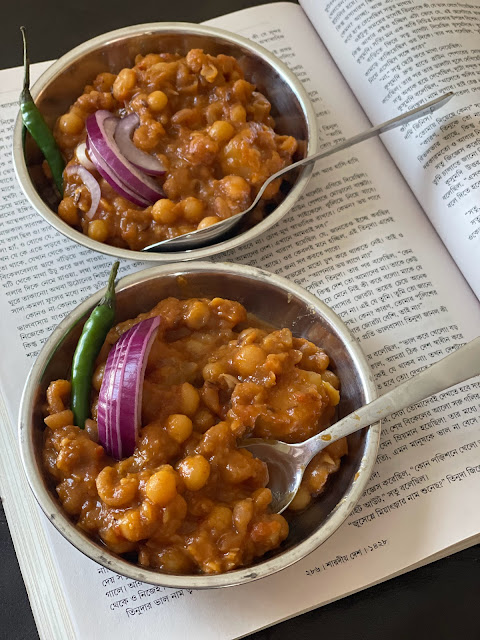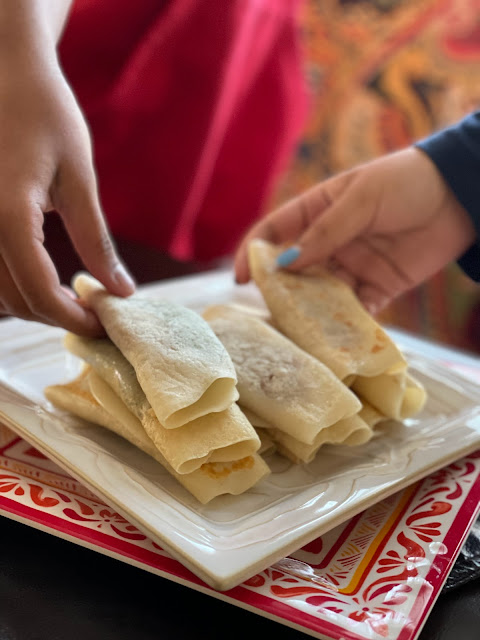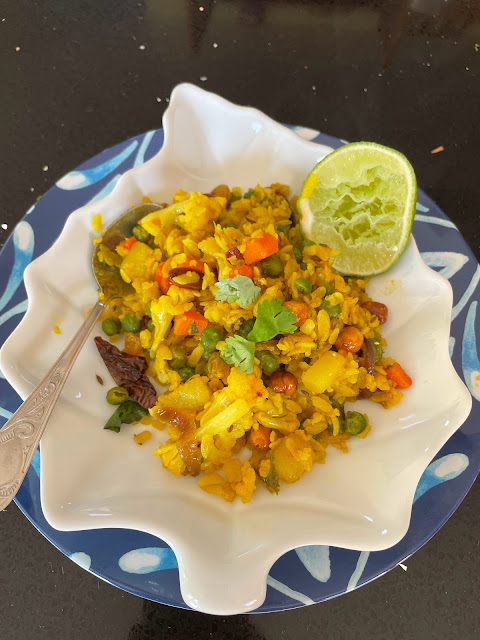Mughlai Parota | Moglai Parota | Spicy Potato Curry
Mughlai Parota or Moglai Parota, a very popular street food in Kolkata, is a rectangular shaped flaky, crispy, fried bread with a filling of eggs, seasoned and cooked ground meat, onions and green chilies. It is served with a spicy potato curry (aloo r tarkari), slices of red onions and sometimes ketchup. The paratha dough is made with flour, water and oil but a good Moghlai paratha will have thin layers and a flaky texture due to rolling tricks unlike the regular parathas. Here, the husband-man has used a genius hack to make exactly those flaky, crispy layered paratha with minimum effort. Read on.
Having lived most of my life in small towns far away from the cultural and food mecca of Bengal. Moglai parota for us was a rare treat. My maternal grandparents lived in North Kolkata and it was our annual "mama r bari" sojourn that promised all of these delicacies. From Flury's pastries to Kheer er Shingara, from egg rolls to aloor chop - the list was endless.
During one of our Kolkata holidays my mamas aka uncles asked if I wanted Moglai Parota for dinner. It was around the time that I had just been introduced to the Mughal empire courtesy of Amar Chitra Katha. As a child I was an avid reader and quick to draw up imaginary visuals in my age. So naturally given its Mughal name, I conjured up a setting of scintillating chandeliers, silken tassels, brocade couches and ornate utensils and could not contain my excitement.
Imagine my situation when instead I was ushered in to a small restaurant with rickety wooden tables and chairs and curtained cubicles called cabins. I was crestfallen and suspicious of those swinging wooden doors of the cabins. I do not remember if it was Anadi Cabin but I was definitely crestfallen by the restaurant and suspicious of those swinging wooden doors of the cabins. That young couples with guilty and flushed faces entering or coming out of them did not help either! I guess I had all the qualities of a judgmental "Bong Mashima" even at that young age.😝
However all of that vanished when the Moglai Parotas and aloo r torakri was served and sheer joy ensued when I took a bite of that Moglai. Later we would also get Moglai parota from a trusted street side stall near my Mama r Bari. They would come wrapped in newsprint packets and perfume our evenings with their delicious, fried fragrance and taste.
The cabin restaurants dated back to the British Raj and the cabins were designed to give privacy to women and also young couples in a society which abhorred any PDA between young lovers. These restaurants, primarily in North Kolkata, were very popular with middle-class Bengalis until the late 80s.One of those restaurants, Anadi Cabin, a 94 year old establishment is what has made Moglai Parota a dish to salivate over and crave for most Bengalis.
Though it is believed that the Mughlai paratha originated during Mughal Emperor Jahangir’s reign (1569-1627) and it was a creation of his cook Adil Hafiz Usman, the Moglai Parota gained popularity among the common man as a street food. Most Bengalis, including me, have no idea about Jahangir but we all know that the best Moglai Parota always comes from, a street side stall, the one on wheels with an aluminum counter top and a kerosene stove raging fire or from one of the old North Kolkata restaurants.
Now since we do not get Moghlai Parota here, we tried many methods to recreate it. Since my rolling skills are pretty bad, we could never get the flaky and layered parota taste which is the USP for Kolkata Moghlai for us. The husband-man therefore came up with this brilliant idea of using Phyllo Dough sheets to make the parota or bread and it was a huge hit. He has been making it for a few years now but the only problem is he doesn't make it frequently :-(
Now what is Phyllo Dough ? Filo or phyllo is a very thin unleavened dough used for making pastries such as baklava and börek in Middle Eastern and Balkan cuisines. We get packaged phyllo dough sheets, which are flaky, layered sheets of tissue-thin pastry dough. The husband-man used sheets of that to make the Moghlai Parota.


















































